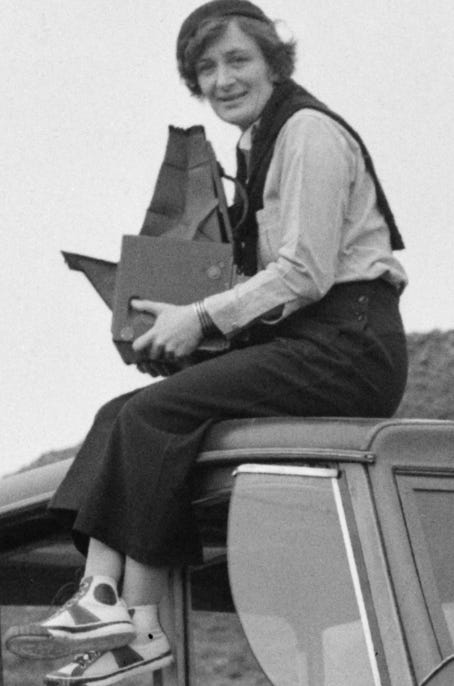TWA from Friday, May 26, 2017
“Watching my Parents Sleeping Beside an Open Window Near the Sea” by Rebecca McClanahan from Deep Light: New and Selected Poems. © Iris Press, 2007.
ORIGINAL TEXT AND AUDIO - 2017
It was on this day in 1521 that German priest and theologian Martin Luther was declared an outlaw and his writings were banned by the Edict of Worms. The edict made Luther more of a hero than he already was, and it’s a big reason that Protestantism caught on so quickly.
Luther decided to become a priest after getting caught out in a thunderstorm one night. He swore to God that if he survived he would enter the religious life. He did survive, and he went on to study theology, become ordained, and get a job as a professor in Wittenberg. As he became more and more involved in the church, he began to grow disgusted with some of its practices. He was especially angry about the church’s sales of indulgences, which were said to decrease the time a person had to spend in purgatory.
On the eve of All Saints’ Day in 1517, Luther nailed to the door of his church 95 theses attacking the sale of indulgences and other excesses of the church. They were originally written in Latin, but they became so popular that people demanded they be translated into German, and so they were. Hundreds of copies were printed up on a printing press, which was still a fairly recent invention, and Luther’s message spread throughout Germany and Europe.
Religious leaders and politicians began to realize how dangerous he was becoming to the traditional church, and in April of 1521, a group of Roman princes pressured Emperor Charles V into forming an assembly in the city of Worms to try to get Luther to reject his writings.
On his trip to Worms, Luther was celebrated as a hero at most of the towns he passed through. He refused to recant and went back to Wittenberg to start the reformation.
It’s the birthday of jazz trumpeter, bandleader, and composer Miles Davis (1926). He was born in Alton, Illinois, and grew up in East Saint Louis. His family was fairly well off, a fact he liked to remind people of, since they tended to assume he came from poverty. His dad was a dental surgeon, and the family had a ranch in Arkansas, where young Miles learned to ride horses. He moved to New York in 1944 to study at the Institute of Musical Art, which is now Juilliard. His true schooling, though, came by way of jam sessions with Charlie Parker and Dizzy Gillespie, and when Gillespie and Parker parted ways, Davis filled Gillespie’s vacancy in Parker’s band.
Always an innovator, Davis formed a nine-piece ensemble in the late 1940s that included a tuba and a French horn; their aim was to re-create the smooth sound of the human voice, and their album Birth of the Cool (1956) heralded the beginning of the “cool jazz” movement. Though it was historically important, it was a commercial failure, and Davis resented the success of later musicians — mostly white — who enjoyed celebrity under the cool jazz banner.
He developed a heroin habit in the early 1950s, due partly to the company he kept and partly to depression over romantic troubles and his lack of critical acclaim. He finally beat the habit in 1954, after locking himself in his room at his father’s house until he had come through the difficult withdrawal symptoms. But he was also musically productive during those years, developing a “hard bop” style. He wrapped up the 1950s by releasing one of the most celebrated jazz albums in history, Kind of Blue (1959), which was based on modal scales rather than chords, and was more melodic than some of his earlier work.
In the late 1960s, Davis began introducing some electric guitar and piano into his records, inspired in part by Jimi Hendrix and James Brown. He cut what some consider his last pure jazz album, In a Silent Way, in 1969, and then moved increasingly toward funk and rock and roll; his jazz-rock fusion double album Bitches Brew (1970) was hugely successful — his first gold record — and won him a lot of new fans even as it alienated his old ones. He was the first jazz musician to be featured on the cover of Rolling Stone, and began opening for rock acts like the Grateful Dead, Santana, and Neil Young.
He broke both ankles in a car accident in 1972, which slowed him down, and checked out of public life altogether in 1975, ill and exhausted and battling a cocaine addiction. There was a three-year period where he didn’t play his trumpet at all, and it took some time to get his chops back when he returned to music in the early ’80s. This time he surprised the critics and fans alike by taking an interest in British New Wave music. He died of pneumonia and a stroke in 1991.
Today is the birthday of photographer Dorothea Lange, born Dorothea Nutzhorn in Hoboken, New Jersey (1895). She contracted polio when she was seven, and her left leg was noticeably weaker than her right for the rest of her life. She came to see that as a kind of blessing: “[It] was the most important thing that happened to me, and formed me, guided me, instructed me, helped me, and humiliated me,” she said. Her father abandoned the family, and her parents divorced, when Dorothea was 12. She had a lot of anger toward her father as a result, and she changed her name, dropping the Nutzhorn and taking her mother’s maiden name, Lange.
She went to the New York Training School for Teachers in 1913, but she had never had much interest in academics. She was more interested in taking pictures. She got a job at a New York studio, studied photography at Columbia, and learned on the job from a number of established photographers. She decided to travel across the country and support herself by selling her pictures. She got as far as San Francisco before the money ran out. She married the muralist painter Maynard Dixon, had a couple of kids, and settled down to a fairly comfortable life taking portraits of the Bay Area’s rich and famous. In the 1920s, Lange and Dixon traveled through the desert Southwest. She took photos of Native Americans, and this was her first real experience with documentary photography, which would be her career and calling for the rest of her life. When she returned home to San Francisco, she began to document the changes she saw around her neighborhood after the stock market crashed in 1929: men in suits standing in breadlines, or waiting near the employment agency, or sleeping on the sidewalk.
In the early 1930s, Lange met a Berkeley professor and labor economist named Paul Taylor. They fell in love and left their respective spouses. They traveled together throughout the United States, documenting the hardships of the Great Depression. Taylor wrote economic reports and Lange took pictures, for the Farm Security Administration. It was during this time that Lange took her most famous photograph: “Migrant Mother, Nipomo, California, 1936.” In 1960, she recalled taking the photograph: “I saw and approached the hungry and desperate mother, as if drawn by a magnet. I do not remember how I explained my presence or my camera to her, but I do remember she asked me no questions. I made five exposures, working closer and closer from the same direction. I did not ask her name or her history. She told me her age, that she was thirty-two. She said that they had been living on frozen vegetables from the surrounding fields, and birds that the children killed. She had just sold the tires from her car to buy food.”
Lange was always respectful of her subjects, and would not photograph them if she could sense that they were uncomfortable. “Her method of work,” Taylor later said, “was often to just saunter up to the people and look around, and then when she saw something that she wanted to photograph, to quietly take her camera, look at it, and if she saw that they objected, why, she would close it up and not take a photograph, or perhaps she would wait until … they were used to her.” She often captioned her photos with the words of the subjects: “Somethin’ is radical wrong” and “I don’t believe the President knows what’s happening to us here.”
During World War II, the War Relocation Authority hired Lange to document the government’s internment of Japanese Americans. She gave up a Guggenheim Fellowship — she was the first woman to receive the prestigious award — to take this post, but the Army felt her photographs were too critical of the internment policy, so they impounded the pictures for decades. Lange also documented the formation of the United Nations in 1945. She and Taylor continued their practice of documenting conditions around the world — he with economic reports and she with her camera. She died of esophageal cancer in 1965.
Lange said: “You know, so often [photography] is just sticking around and being there, remaining there, not swooping in and swooping out in a cloud of dust; sitting down on the ground with people, letting the children look at your camera with their dirty, grimy little hands, and putting their fingers on the lens, and you let them, because you know that if you will behave in a generous manner, you’re very apt to receive it, you know? People are very, very trusting; and also, most of us really like to get the full attention of the person who’s photographing you. It’s rare, you don’t get it very often. Who pays attention to you, really, a hundred percent? You doctor, your dentist, and your photographer.”
Be well, do good work, and keep in touch.®
THE WRITER’S ALMANAC PAPERWEIGHT - CLICK HERE






I was introduced to Dorothea Lange in a college course of B & W Photography. Her exposures left an imprint as a restless senior. The sense of realism made me rethink how ordinary people are treated.
I miss photography that captures an essence of America unseen. She taught me a lot in that semester of taking pictures of rubenesque nudes as part of the curriculum. Dorothea's guests were clothed yet it felt very naked in how emotions were wrought. So Thank You Dorothea Lange from my deepest heart to thee.
I apologize for being critical but I thought your summation of Luther was a bit misleading and misled. He was angry about indulgences but more critical of church dogma that said God's favor could be bought or earned. And he never wanted to lead a reformation as it became. He had to go into hiding because many of the authority figures of the time wanted him killed. He wrote out of conscience and a search for the truth. I guess the point I see missing here is that Luther was compelled to his writing and though it put him in terrible jeopardy, he couldn't recant and be true to God. He didn't intentionally set up a new church. He wrote to reform the one he cared for.